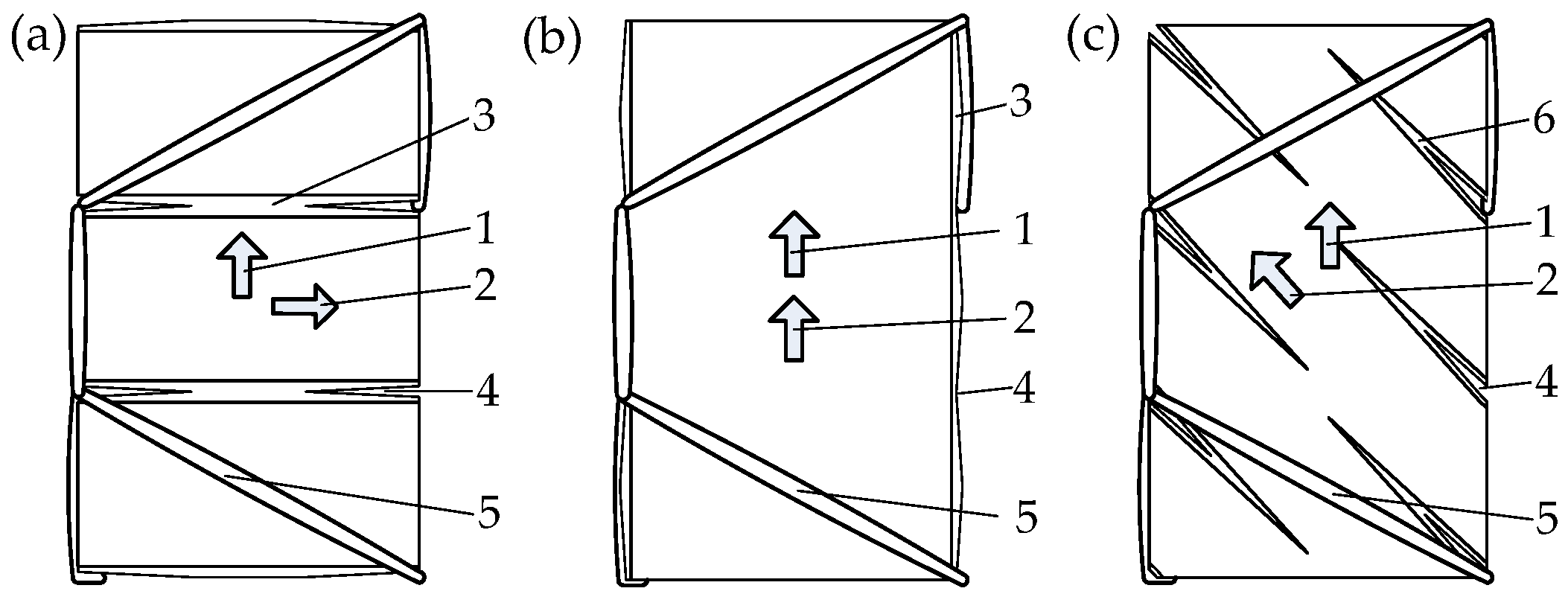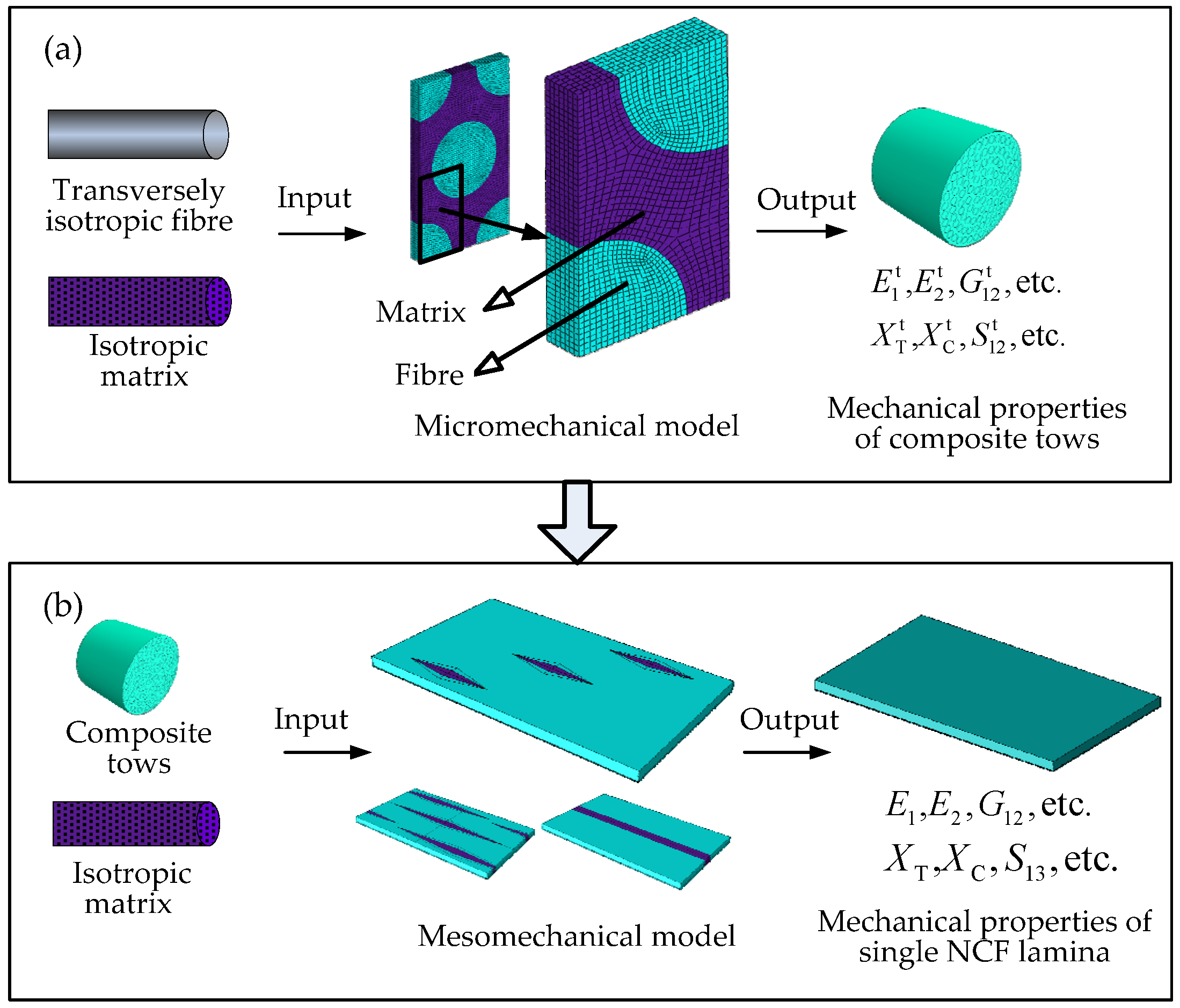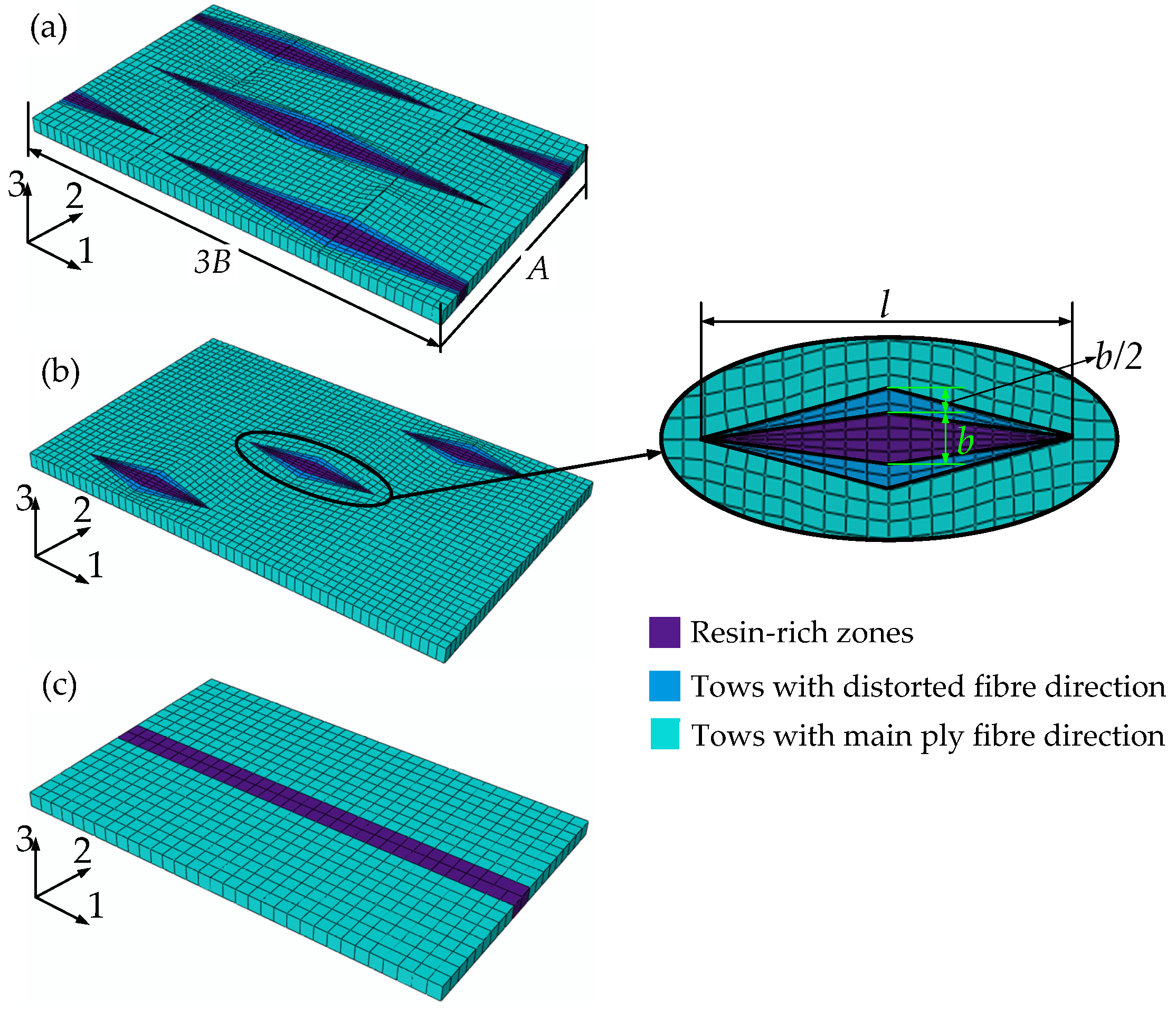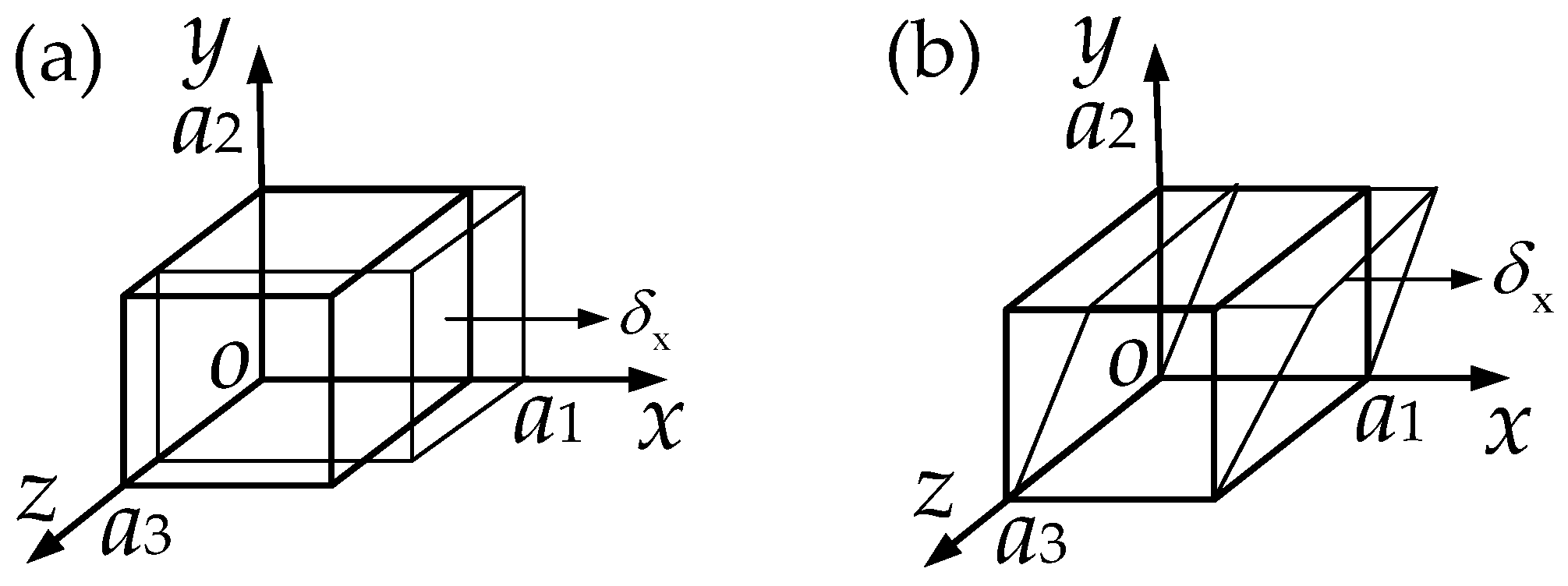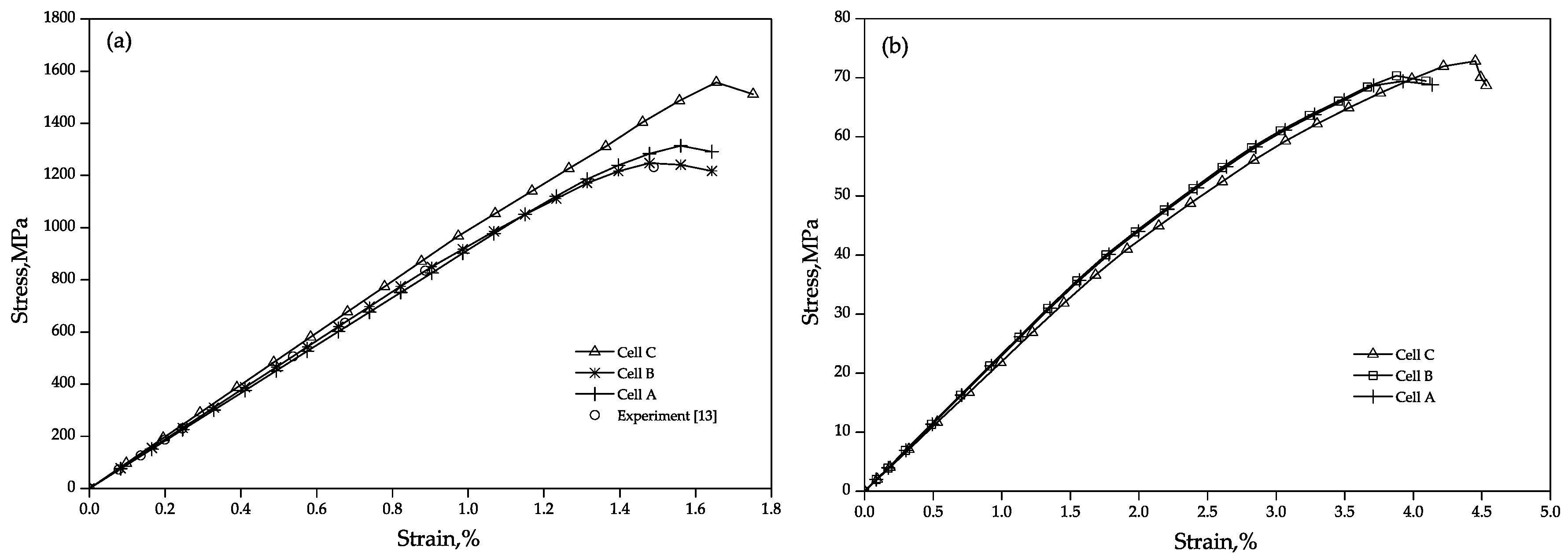The stiffness and strength of QNCF lamina are obtained using the meso-scale analysis procedure. The numerical predictions of QNCF lamina are compared with the experimental results of the non-crimped UD laminate in Reference [
13]. In the experiment, mechanical properties of non-crimped UD specimens with warp-knitted was reported, however, that is just one the types of UD specimens mentioned in this paper.
4.1. Mechanical Properties of the UD Composite Tows
In QNCF lamina, the area except for resin-rich zones can be considered as UD composites, and
of the outer and inner plies are different. The QNCF fabric laminate to be analyzed by the mechanical models with
= 42.1%. This fiber volume fraction is experimental measurements values in Reference [
13]. In this case, according to Equation (1),
is shown in
Table 3. As the diameter of inner stitching yarn for the QNCF layer is small, the volume of the resin-rich zones is about 3.34% of the total volume of the NCF lamina, which contributes to
in the inner −45° and 90° lamina close to
as shown in
Table 3. In addition, the stitching yarn can cause obvious fiber cracking in the outer 45° and 90°, which makes
in outer layer higher than that in inner layer.
The mechanical properties of composite tows obtained with the micro-scale analysis procedure are shown in
Table 4.
,
,
,
, and
are calculated by the numerical homogenization method, and
and
are determined by transversely isotropic material assumption. The stiffness properties of the UD tows estimated by an averaging technique based on the rule of mixtures (RM) [
26] is also given in
Table 4. This analytical model can calculate the value of
and
, but has a less accurate result for
and
because of the assumption of rectangle section for fiber. Therefore, the analytical values of
,
are used in this section.
According to
Table 4, it is clear that the results obtained using the numerical models are consistent with those obtained using the RM. Among the unit cells, composite tows in Cell A has the highest fiber volume fraction (
), correspondingly, the longitudinal Young’s modulus of the tows is also higher than the other two cases. This is because the longitudinal Young’s modulus of composites is a fiber-dominated property. For the numerical predictions of
and
, the tows with high local fiber volume fraction also has a larger transverse and shear modulus compared with low fiber volume fractions. This can be interpreted that although the transverse and shear modulus of UD composite materials are matrix-dominated, the fiber volume fraction, the ratio of matrix property and fiber property also affects the modulus simultaneously [
26].
“Ref-RM” is reference value obtained with the rule of mixtures, and “Ref-FEM” is reference value obtained by micromehanical model for UD un-stitched composites, and “In Cell A”, “In Cell B” and “In Cell C” mean that the composite tows in Cell A, Cell B and Cell C, respectively.
The numerical predicted strength properties of composite tows with different fiber volume fractions are shown in
Table 5. The analytical values of
and
based on the RM are also presented for a comparison. The analytical values are obtained by Equations (20) and (21). The existing simple analytical models cannot accurately predict transverse strength and shear strength at the micromechanical level. Therefore, the analytical results of
,
, and
are not presented here.
where
is the matrix volume fraction of composite tows.
Compared with the reference values (Ref-RM), the numerical predictions value (Ref-FEM) and of composite tows are decreased by 14.5% and 27%, respectively. Although the difference is obvious, considering that the RM is less accurate in the prediction of strength than the predicting of elastic properties, this comparison just illustrates the possible strength value of this material with different volume fraction. Therefore these strength properties of UD tows obtained by micromechanical model still can be used for the calculation of the meso-scale model, and this paper compares the numerical predicted and experimental values on the mesoscale.
4.2. In-Plane Stiffness of QNCF Lamina
According to the inter-structure of QNCF lamina, three kinds of unit cells have been established. Certainly, the predicted results with any of the three unit cells cannot represent the actual values. As the method of taking data average is commonly used in the data processing of composite stiffness test, the averaged value of the predicted results employing the three unit cells is taken as stiffness properties of the QNCF lamina.
The displacement load is applied on the surface of the three kinds of representative volume elements, and the deformation and stress distribution of the three unit cells are shown in
Figure 7.
The estimated in-plane effective engineering constants
,
,
, and
are listed in
Table 6. The averaged stiffness of the three unit cells and the numerical homogenization results obtained by micromechanical model for UD composite tows are also presented in
Table 6 as a reference.
The averaged stiffness obtained with the three unit cells are in a good agreement with experimental results. The elastic data of UD laminate test in Reference [
13] are used in this comparison. The average value of
and
are 0.9% and 6.3% higher than the corresponding experiment results, respectively, and the average value of
is 5.3% lower than the test value. Considering that, the procedures for predicting the stiffness is done in the linear elastic range of the material, and the stiffness of the constituent materials attributed to the numerical calculation are experimental data, and reasonable boundary conditions are used in the numerical homogenization method, which make it possible to get a relatively accurate results.
When we compare the average value with the reference value (Ref-FEM), as shown in
Table 6,
is reduced by 3.34%, but this difference is not significant. The maximum difference of
is about 4.8% among the three unit cells. To consider the same averaged fiber volume fraction, this difference in the elastic properties could be caused by fiber distortion. This result is consistent with the view of Reference [
13], which concluded that absence of a significant difference in stiffness between experimental results and classical laminate theory predictions. We confirm this conclusion by multiscale analysis. Stitch yarn induces the localized crack in the fibrous ply. If the width of the localized crack is seen as the amplitude of fiber waviness, the amplitude of a single crack (for large crack,
b = 0.48 mm) accounts for 9.5% of the unit cell width (
A = 5.07 mm). With a constant fiber volume fraction, these localized in-plane cracks are such small amplitude and waviness angle that effect on stiffness might be not obvious. Stitching has minor effect on the in-plane stiffness of continuous plies, which is different from traditional conclusions. It is generally considered that the stitching can reduce the in-plane stiffness by 10%–20% [
15,
27], these contrary conclusions may only be applicable for stiffness of the open structure NCF composite.
For
and
, the average values are almost the same as the reference values (Ref-FEM in
Table 6): they are reduced by 1.7% and 1.3% compared to the reference values, respectively. The transverse and shear modulus of the QNCF lamina are separately close to the UD. The possible reason for this phenomenon is that the stitch yarn induces fiber distortion, which occurs in the direction of fiber tows, and the transverse and shear modulus of composite materials are matrix-dominated. Moreover, considering that there is no change in matrix properties, the difference between the predictions employing the three unit cells and the reference value is not obvious.
4.3. In-Plane Strength of QNCF Lamina
The in-plane strength is predicted by meso-scale failure model. The progress failure model is introduced in
Section 3.3.3 that used to predict the failure of composite tows. The von Mises criterion and the Drucker–Prager yield criterion are introduced to predict the failure of the resin pocket under different loads. Failure analysis is performed by the Abaqus commercial FE code combined with the user subroutine UMAT, axial displacement load and in-plane shear load are applied on the surface of the unit cells, and then the predictions of in-plane strength are listed in
Table 7.
The strength data of non-crimp UD laminate that tested in Reference [
13] are used in this section as a comparison. Each of these three unit cells represents a QNCF lamina, and the predicted strength of each unit cell represents possible values of the QNCF lamina. For these reasons, the individual prediction of each unit cell and average value are both compared with experimental results. Similar to that described above, the averaged value of the predicted results is taken as strength properties of the QNCF lamina.
Compared with the experimental results in reference [
13], the average value of
obtained using the above three unit cells is 11.4% higher than the experimental results.
Figure 8 shows the fiber tension failure modes in the unit cells and
Figure 9a presents the stress-strain response of the unit cells subjected to uni-axial tension parallel to fiber. As shown in
Figure 9a, the numerically determined curves agree well with the experiment, although a slight overestimate of the tensile strength is observed.
Although fiber reinforced composite materials are often considered as brittle materials, a certain non-linear behavior is observed in
Figure 9a. This non-linear behavior is caused by material stiffness degradation after local failures within the composite tow. In fact, the test data in Reference [
13] also have a stiffness reduction. For non-crimp UD laminate in the test, the initial Young’s modulus is 94.3 GPa, and Young’s modulus is 82.8 GPa in the end of the test. It can be concluded that stiffness of the laminate is reduced by 12.2% at the ultimate failure.
As shown in
Figure 9a, the curves of Cell A and Cell B have more obvious stiffness reduction compared with that of Cell C. This result can be explained by the rhomboidal cracks in the laminas which are more likely to cause stress concentration compared with the channels in the 0° lamina. The QNCF layer discussed in this work is composited with four laminas, and three laminas are provided with the cracks, so the lamina with the cracks is more representative of the actual stress state. Compared with Cell C, Cell A and Cell B are unit cells with cracks, thus the numerical predictions employing these two kinds of unit cells are closer to the experiment values.
From
Table 7,
is 15.3% higher than test value, and the average shear strength is close to test value. For composite tows under shear loading, the nonlinear behavior of material should be considered in failure analysis. Generally, this nonlinear behavior is caused by micro crack and plasticity of matrix. According to the failure model above, the internal state variables of material degradation are used to analyze the combined influence of the two factors. The engineering analysis method is also used in Reference [
21] to predict matrix shear cracking. Based on this method, the stress-strain response of the unit cells subjected to simple shear load are shown in
Figure 9b. The stiffness decreased about
due to local damage in matrix according to
Figure 9b. After elastic range, the nonlinear curves are obtained. With the progressive damage method, reasonable shear behaviors are obtained. However, since mechanical properties of the fiber/matrix interface are modeled perfectly in a conventional mesh, a high transverse strength value is predicted. Considering the dispersion parameters of strength of composites and the reference experiment is only for one type of non-crimped UD specimen, therefore, the three unit cells given here can predict in-plane strength of the QNCF lamina with sufficient engineering accuracy.
As can be seen in
Table 7, in the fiber direction, the longitudinal tensile strength
obtained by employing Cell B with fiber waviness is 19.8% lower than Cell C, and the average value of
is 23.4% lower than the reference value (Ref-FEM). For longitudinal compressive strength
, the maximum difference among the three unit cells reaches to 28.0%. Generally, the differences between mechanical properties obtained using the cells with fiber waviness and the cell with no waviness are quite obvious. The average value can still be reduced by approximately 20% relative to the reference value. Considering the same volume friction of the three unit cells, this difference could be caused by the local stress concentration, which is a result of fiber waviness induced by the stitch yarn in this material. This difference between the three unit cells or difference between the average value and the reference value is obvious. Moreover, this may explain the results of Bibo [
14] who found that the tensile strength of NCF composite is 34.7% lower than the UD composites and the compress strength is 40% lower than the UD, which is caused by the effect of the stitching in the materials.
The difference of or between the three unit cells and the corresponding reference value (Ref-FEM) is not obvious, is also a similar trendy. This indicates that fiber disturbance has no significant effect on the strength in the direction transverse to the fibers. According to the failure mechanism, the transverse strength and shear strength are also matrix-dominated, and it has little relation with the strength of the fiber itself. Therefore, the changes of transverse and shear strength of NCF lamina caused by fiber disturbance are insensitivity.


